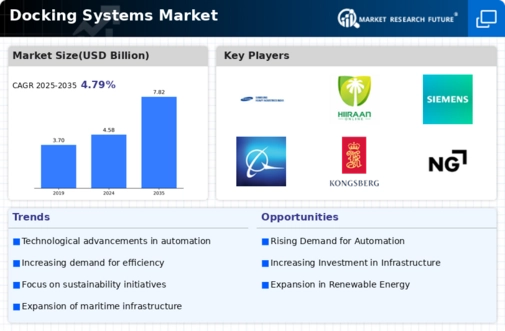Top Industry Leaders in the Docking Systems Market

Key Players
Metaltech
NIJL Aircraft Docking
CTI Systems
Kawasaki Heavy Industries
Zarges
Turner Access Ltd
REEL SAS
Altech
Kern Steel Fabrication, Inc.
Strategies Adopted
Current investment trends in the Docking Systems industry underscore a focus on research and development, product diversification, and market expansion. Key players are directing investments towards developing next-generation fender systems, automated mooring solutions, and predictive maintenance tools for docking infrastructure. Investments in digital twin simulations, IoT sensors, and cloud-based platforms are prevalent, reflecting the industry's shift towards data-driven decision-making and asset management. Additionally, strategic investments in sustainability initiatives, such as eco-friendly materials and energy-efficient technologies, aim to align docking system solutions with evolving environmental regulations and customer preferences.
The overall competitive scenario in the Docking Systems market is characterized by established manufacturers, technology providers, and service integrators, each navigating the industry with distinct strategies. Market share analysis considers factors such as product performance, innovation capabilities, customer relationships, and global reach. The industry's responsiveness to technological advancements, customer feedback, and market dynamics further shapes competitiveness. As port infrastructure continues to evolve to meet growing maritime traffic demands, companies in this sector are focused on delivering reliable, efficient, and sustainable docking system solutions that enhance port efficiency, safety, and environmental stewardship.
Emerging Companies
As the demand for docking systems continues to rise, new and emerging companies are entering the market, contributing to innovation and product development. Start-ups and specialized firms such as ShibataFenderTeam AG, JIER Marine Rubber and Engineering Co., Ltd., and Mampaey Offshore Industries BV are gaining recognition by providing novel docking solutions tailored to specific port and vessel requirements. These companies leverage expertise in materials science, engineering design, and maritime technology to develop resilient fender systems, quick release hooks, and automated mooring solutions that improve port operations and vessel safety. The industry is witnessing a trend towards the development of integrated docking systems, smart monitoring solutions, and eco-friendly materials, aligning with the broader maritime industry's sustainability goals.
Industry news within the Docking Systems market reflects ongoing trends, regulatory changes, and technological advancements driving the sector forward. News related to successful docking system installations, port expansion projects, and advancements in mooring technology showcase efforts to enhance port infrastructure and operational efficiency. Moreover, developments in docking system standards, safety guidelines, and environmental regulations are frequently covered in industry news, highlighting the importance of compliance and risk management in port operations. Additionally, news related to industry conferences, exhibitions, and trade shows underscore the collaborative nature of the docking systems market and the knowledge-sharing initiatives aimed at fostering industry innovation and best practices.
Recent News
Airbus (France):
Focus on Automated Docking Systems for Satellites: Airbus develops advanced robotic arms and docking mechanisms for autonomous satellite servicing missions, enabling on-orbit repairs and extending satellite lifespans.
Partnership with ESA: Airbus collaborates with the European Space Agency on the vision of future space stations utilizing automated docking technologies.
Blue Origin (USA):
Emphasis on Reusable Launch Vehicle Docking: Blue Origin's New Shepard and New Glenn rockets utilize innovative docking systems for mid-air refueling and payload transfer, paving the way for cost-effective space missions.
Focus on Orbital Transfer Vehicles: Blue Origin develops Orbital Transfer Vehicles (OTVs) equipped with docking capabilities, facilitating cargo and crew movement between space stations and other spacecraft.
Mitsubishi Heavy Industries (Japan):
Focus on Docking Systems for Lunar Landers: Mitsubishi Heavy Industries builds the H3 rocket and plans for Lunar Exploration Vehicle (LEV) equipped with automated docking capabilities for future lunar missions.
Partnership with JAXA: Mitsubishi collaborates with the Japanese Aerospace Exploration Agency (JAXA) on lunar exploration technologies, including reliable and efficient docking systems.
Kongsberg Maritime (Norway):
Emphasis on Ship-to-Ship and Ship-to-Shore Docking Solutions: Kongsberg develops automated mooring and docking systems for various vessels, enhancing safety and efficiency in port operations and offshore transfers.
Focus on Dynamic Positioning and Control Systems: Kongsberg's advanced positioning and control technologies underpin their docking systems, ensuring precise alignment and movement during critical maneuvers.
Intuitive Surgical (USA):
Focus on Robotic Docking in Minimally Invasive Surgery: Intuitive Surgical's da Vinci surgical robots utilize precise docking mechanisms to connect laparoscopic instruments and facilitate delicate surgical procedures.
Emphasis on Advanced Docking Features: Intuitive Surgical continues to develop new features for their docking systems, improving surgical precision, dexterity, and patient outcomes.
Emerging Trends in Docking Systems:
Increased automation and autonomy in docking procedures across various applications.
Advancement in sensor technology and machine learning for precise and reliable docking.
Focus on miniaturization and modularity for adaptable docking solutions in diverse environments.
Emphasis on cybersecurity and data protection in connected docking systems.
Exploration of docking applications in new frontiers, such as underwater exploration and asteroid mining.


